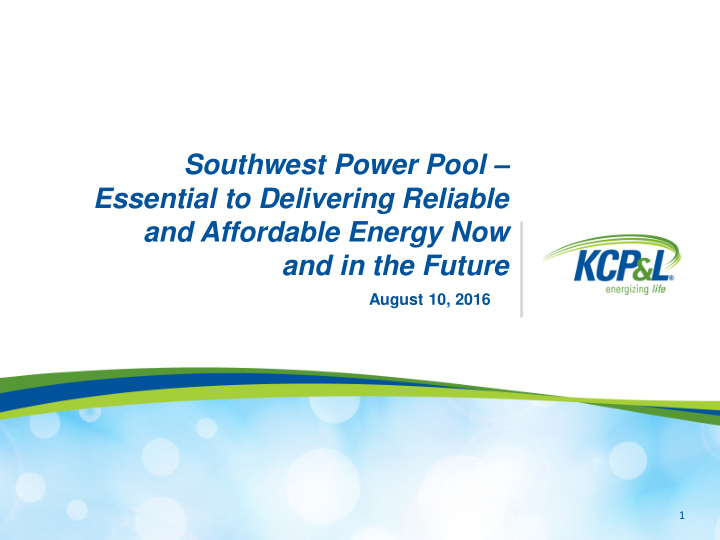



Southwest Power Pool – Essential to Delivering Reliable and Affordable Energy Now and in the Future August 10, 2016 1
Highlights • Safety Message • The Big Picture • Southwest Power Pool’s Role • The Challenge – Managing the Variables • Reframing the Vision of Transmission • Value of Transmission • Who Pays for Transmission Projects? 2
Safety Message KCP&L Safety Culture • Every Company meeting begins with a safety message • The messages promote safety awareness in the workplace and home • Customer safety education initiatives A couple of entries from 2016 KCP&L Safety Calendar Contest 3
The Big Picture: The Regulators A wide variety of regulations impact Availability, Mitigating Disruption, Cost and Price of Electric Service. NERC FERC MPSC/KCC DHS SPP RE Environmental Generation Transmission SPP RTO DOE Distribution Cost/Price 4
SPP’s Increasingly Essential Role 1968 Became NERC Regional Council 1980 Implemented telecommunications network 1991 Implemented operating reserve sharing 1994 Incorporated as nonprofit 1997 Implemented reliability coordination 1998 Implemented tariff administration 2004 Became FERC-approved Regional Transmission Organization 2007 Launched EIS market; became NERC Regional Entity 2009 Nebraska utilities joined SPP 2010 FERC approved Highway/Byway cost allocation methodology and Integrated Transmission Planning Process 2014 Launched Integrated Marketplace 2015 Integrated System joins SPP Source: SPP Presentation, Intro to SPP, 07-26-2016 5
Southwest Power Pool’s Role SPP’s Mission: Helping our members work together to keep the lights on, today and in the future. SPP Regional Transmission Operator SPP Regional Entity (RE) (RTO) Real-time Electric Power Grid Operation NERC Delegated, FERC Approved Authority Reliability Coordinator Compliance Monitoring and Enforcement Tariff Administration NERC Registration and Certification Regional Scheduling Event Analysis / Reliability Assessments Transmission Expansion Planning Education and Outreach Market Operations Training 6
The Challenge – Managing the Variables Generation Efficiency Transmission Weather Constraints Unplanned Transmission Outages Availability Planned Renewables Maintenance Mix Daily Demand Cycle 7
SPP Is Member-Driven Collaborate and Support Advise – Informed Decisions Member Approximately 70 Working Groups Driven and Committees Approximately 30 KCP&L Employees Participate and/or Monitor Working Groups and Committees 8
Reframing the Vision of Transmission In the past Today Individual utilities planned and Utilities collaborate, through built transmission to meet participation in RTOs, to their “local” reliability and proactively plan and build generation needs transmission “highways” that benefit region as well as local • Resulted in infrastructure additions service to meet minimum reliability standards • Facilitates new generation additions, • Did not facilitate the efficient including renewables utilization of existing generation • Improves electric reliability, region-wide operational efficiencies, and access • Did not consider opportunities for to lower-cost and diverse generation the addition of competitive new resources generation • Enables more competitive wholesale energy markets 9
Value of Transmission: Benefits • Benefit Cost Ratio of 3.5 : From 2012 to 2014, SPP installed almost $3.4B of transmission expansion projects, benefits of the projects expect to exceed $16.6B. Benefits include: – More Efficient Utilization of Generation: • Reduces Transmission Congestion • Improves Access to Markets • Increases Competition • Increases System Efficiency • Defers Generation Capacity Investment • Access to Lower Cost Generation Source: SPP’s The Value Of Transmission Report, 01-26-2016 10
Value of Transmission: Other Benefits • Enables Access To Renewables : SPP’s wind generation mix in 2007 was less than 1%, in 2015 wind represents 15%, and continues to grow. • Advances Public Policy : – Improves reliability; – Serves new population centers; and – Manages diverse fuel types to meet environmental goals. • Stable and Reliable System : Transmission investment expands operational flexibility in a variety of conditions. Source: SPP’s The Value Of Transmission Report, 01-26-2016 11
Who Pays For Transmission Projects? • Sponsored : Project owner builds and receives credit for use of transmission lines • Directly-assigned : Project owner builds and is responsible for cost recovery and receives credit for use of transmission lines • Highway/Byway : Most SPP projects paid for under this methodology Voltage Region Pays Local Zone Pays 300 kV and above 100% 0% Above 100 kV and below 300 kV 33% 67% 100 kV and below 0% 100% Source: SPP Presentation, Intro to SPP, 07-26-2016 12
Did We Get What We Paid For? SPP Regional Cost Allocation Review • Regular Review of Transmission Project Cost Allocation : This triennial analysis is to measure by zone the cost allocation impacts of SPP’s Highway/Byway methodology. • Aligns Charges with Long Term Benefits : A tool to confirm allocation of SPP participants’ costs align with SPP’s Highway/Byway methodology. • Benefit Cost Ratio : Provides analysis of participants’ benefit cost ratio based on a participants’ operations and investment. – KCP&L Zone’s Benefit Cost Ratio : 2.97 – GMO Zone’s Benefit Cost Ratio : 2.15 Source: SPP Regional Cost Allocation Review Report for RCAR II, 07-11-2016 13
In Summary • Many regulations play a part in promoting availability, mitigating disruption, cost and price of electricity. • SPP provides efficiency in managing the variables and optimizing the energy markets. • Transmission is valuable: – Enables access to renewable generation resources – Advances public policy – Assures a stable and reliable energy delivery system 14
15
Recommend
More recommend